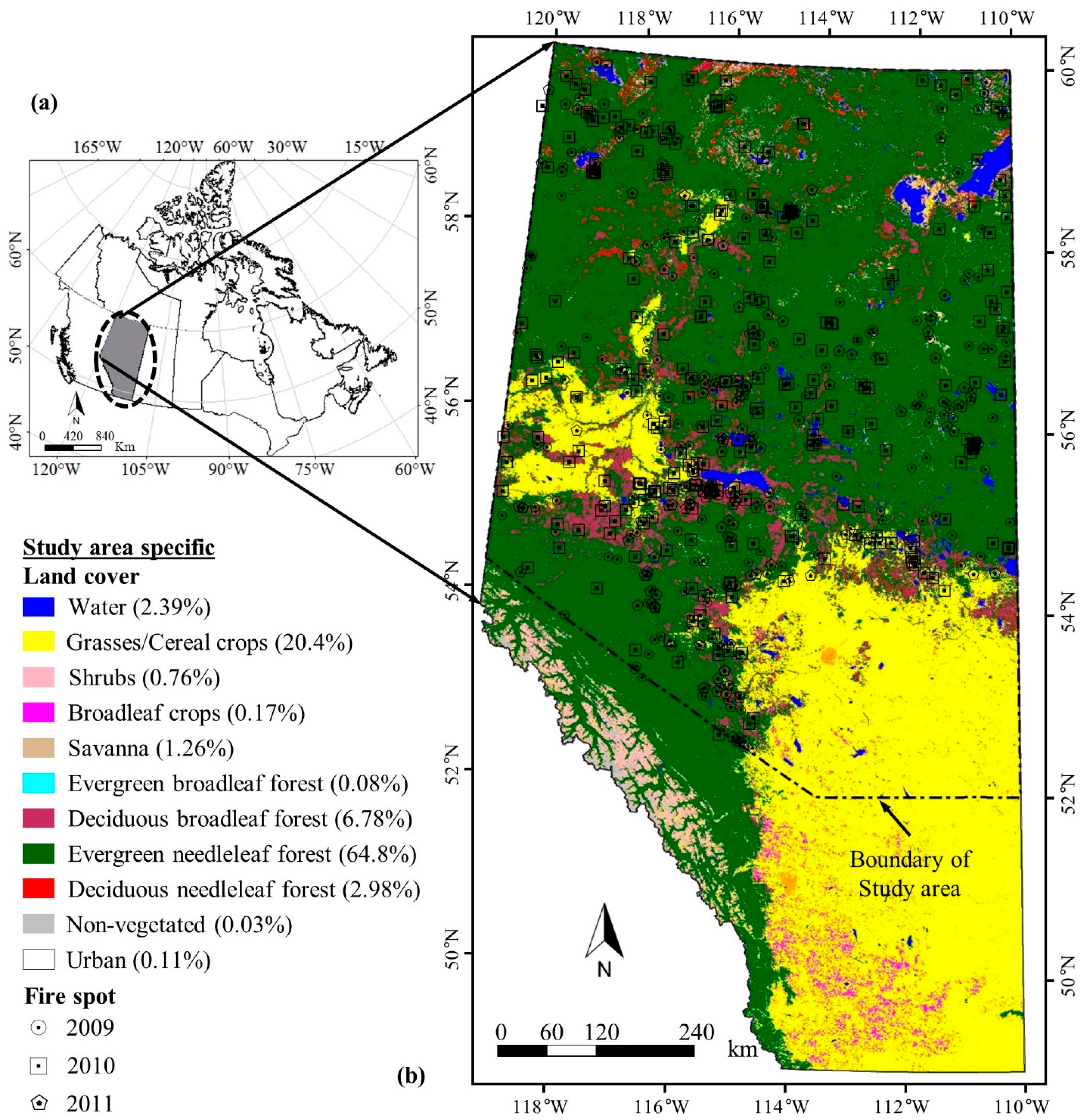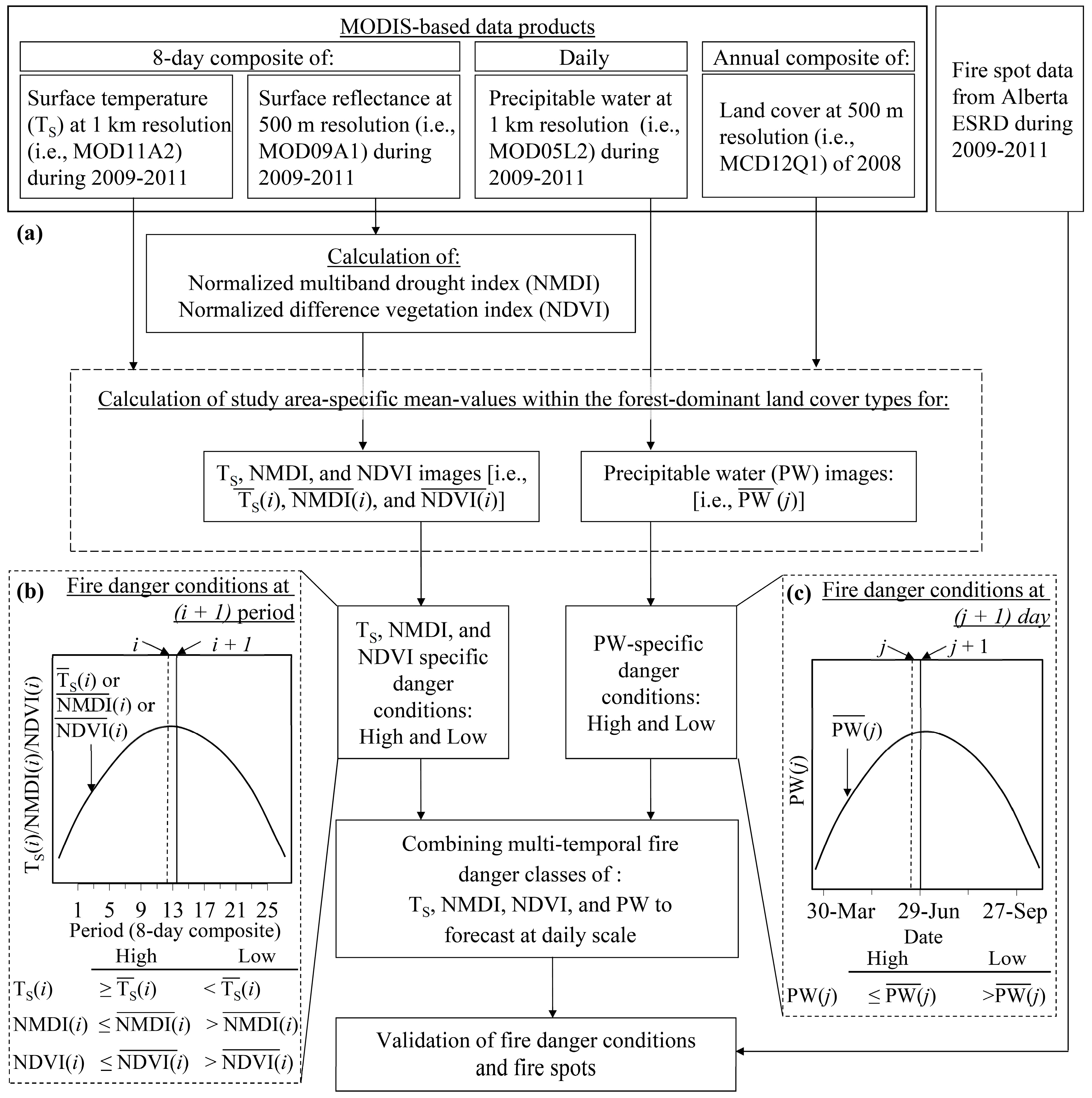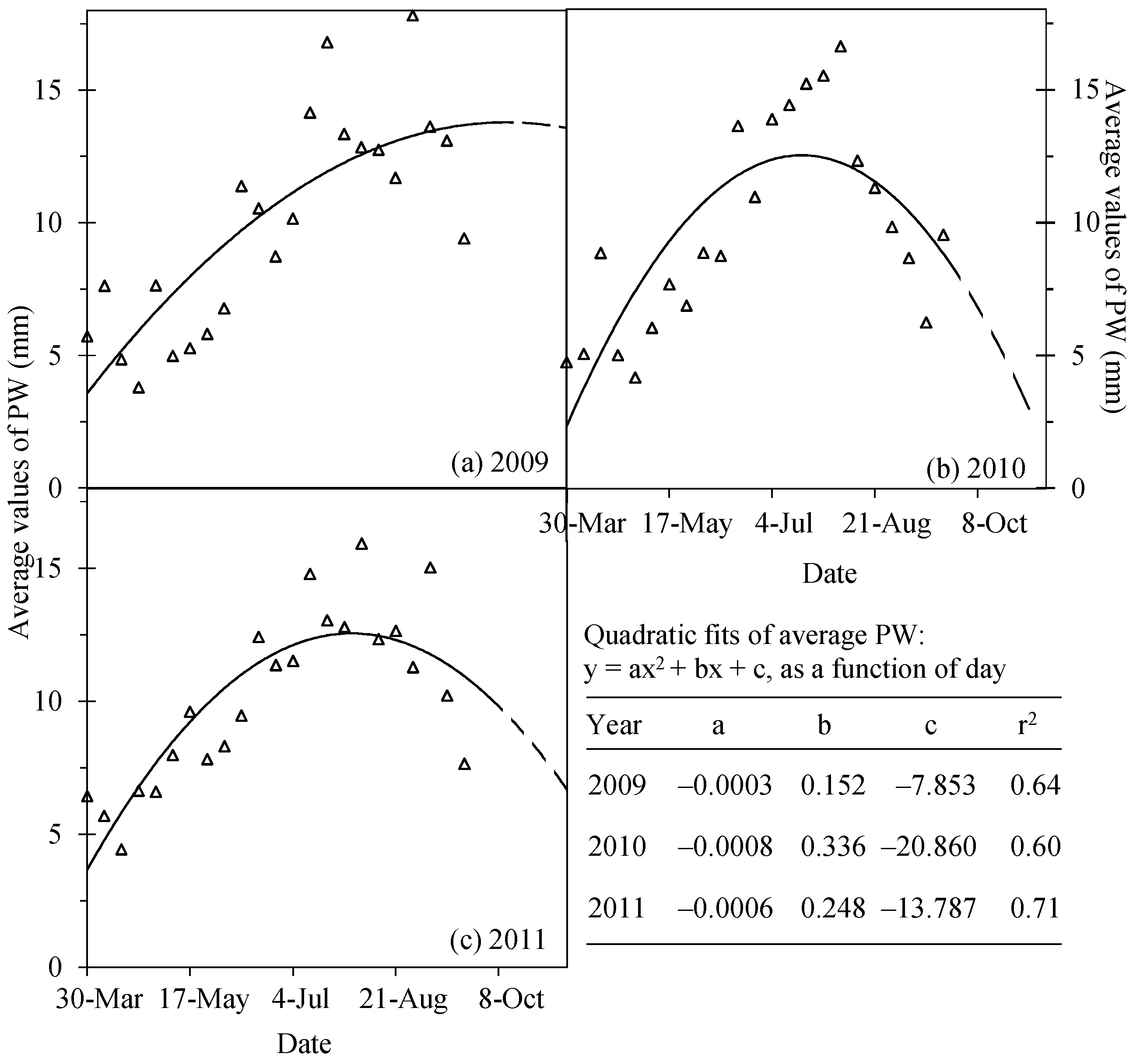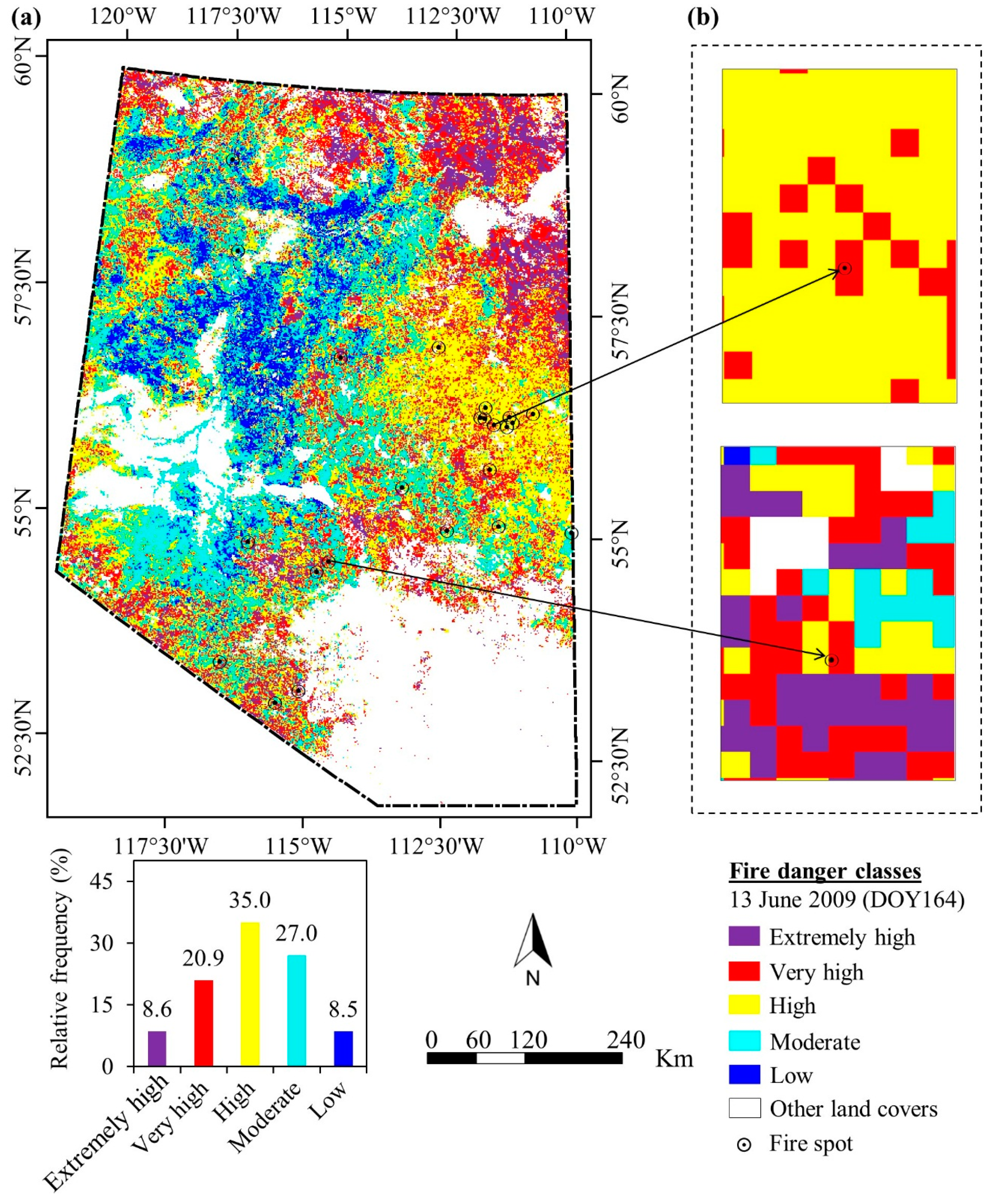Development of a New Daily-Scale Forest Fire Danger Forecasting System Using Remote Sensing Data
Abstract
:1. Introduction
- Vidal and Devaux-Ros [38] employed Landsat TM images to calculate TS and NDVI in conjunction with meteorological station-based Ta data to calculate the water deficit index (WDI) over the Les Maures Mediterranean forests in southern France during 1990–1992 and observed that 100% of the fire pixels were captured in location where the pre-fire WDI value was ≥0.6. The major weakness of the study was the use of only 3 satellite images. Thus the researchers thought to conduct extensive validation, which was not carried out (Vidal, personal communication).
- Guangmeng and Mei [39] utilized MODIS-based TS images over the forested regions of northeast China during April and May of 2003. They found that TS-values were increasing at least 3 days prior to the fire occurrences; however, their rate of increase was not quantified.
- Oldford et al. [40] applied AVHRR-derived TS and NDVI images over the northern boreal-forested regions of the Northwest Territories in Canada during 1994. They also found that the TS-values had an increasing trend at least 3 days prior to fire occurrences like [39], while NDVI did not demonstrate clear indications. Also, TS values were evaluated against the meteorological variable-derived FWI code, and revealed a reasonable relationship over burned (i.e., r2≈ 0.55) and unburned (i.e., r2≈ 0.65) forested areas. In general, the use of either NDVI or TS might be unable to depict the dynamics of fire danger conditions, as danger would depend on many other biophysical variables.
- Bisquert et al. [27] used MODIS-based 16-day composite EVI difference images and period of year for calculating fire occurrence over Galicia, Spain during 2001–2006 and found an overall accuracy of 58.2% when compared with observed fires. In this study, the input variable (i.e., EVI of 250 × 250 m resolution) was resampled into low spatial resolution (10 × 10 km), which could not depict the spatial variability of vegetation type and conditions, and prediction for a 16-day period was inappropriate for day-to-day forecasting purposes.
- Akther and Hassan [41] exploited a MODIS-derived 8-day composite of TS, NMDI, and temperature-vegetation wetness index (TVWI) images over the boreal forested regions of Alberta, Canada during 2006–2008. They showed encouraging results, i.e., 91.6% of the fire pixels were found in “very high” to “moderate” danger classes. There were three critical issues: (i) cloud contaminated pixels (i.e., data gaps) were excluded from the analysis; (ii) the method for calculating TVWI was complicated and highly dependent on the skill of the personnel; and (iii) forecasting was done on an 8-day scale instead of a daily scale. In another study [42], the first two issues were addressed by employing (i) a gap-filling algorithm and (ii) NDVI instead of TVWI. They applied it over the boreal forested regions of Alberta during 2011 and found similar results (i.e., 98.2% of the fires fell under “very high” to “moderate” danger categories) like [41].
2. Study Region, Data, and Methods
2.1. General Description of Study Area
2.2. Data Requirements

- Though both TS and surface reflectance data (which were used to calculate NMDI, and NDVI) were available at daily temporal resolution, we employed their respective 8-day composite. This was because the computation of all these variables would be highly influenced by the atmospheric conditions, in particular the presence of cloud [50,51], which was critical in reducing the amount of cloud-contaminated pixels.
- The 8-day composite of TS images were generated by averaging the TS images acquired under clear-sky conditions at approximately 10:30 am local time [52]. Thus, these values might not represent the daily variations and/or maximum temperature.
- The 8-day composite of MODIS surface reflectance data used to calculate NMDI and NDVI was generated based on minimum-blue criterion, which coincided with the best clear-sky condition day during the composite of interest [53,54]. As such, two consecutive 8-day composite images might be apart in the range of 2 to 16 days. In addition, NMDI and NDVI variables were less dynamic in the temporal dimension, i.e., wetness/greenness condition of forest vegetation might not change over a short time period even though the vegetation would experience stresses [26].
2.3. Implementation of a Gap-Filling Algorithm
2.4. Development of a Daily-Scale FFDFS

3. Results and Discussion
3.1. Evaluation of the Impact of Daily PW on the Fire Danger Condition

- Clabo and Bunkers [65] found that most of the fires occurred in South Dakota when the PW in the 800–700 mb layer (i.e., ~1.8–2.7 km above the ground surface) was below or around the monthly -levels;
- Sitnov and Mokhov [47] observed the daily PWs were highly anomalous (i.e., water vapor content was low compared to that of the ten years average-values) during 23 July to 18 August 2010 over European Russia when more than 60% of the fires took place; and
- Akther and Hassan [41] reported that most of the fire occurrences were found within the “average ± 1 standard deviation” for the variables TS, NMDI, and TVWI over boreal forested regions of Alberta.

3.2. Evaluation of Daily-Scale FFDFS System
| Year | No. of Variables Fulfilling the Danger Condition | Fire Danger Categories | % of Data | Cumulative % of Data |
|---|---|---|---|---|
| All | Extremely High | 8.95 | 8.95 | |
| At least 3 | Very High | 28.36 | 37.31 | |
| 2009 | At least 2 | High | 36.57 | 73.88 |
| At least 1 | Moderate | 20.90 | 94.78 | |
| None | Low | 5.22 | 100.00 | |
| All | Extremely High | 14.88 | 14.88 | |
| At least 3 | Very High | 30.95 | 45.83 | |
| 2010 | At least 2 | High | 30.36 | 76.19 |
| At least 1 | Moderate | 19.64 | 95.83 | |
| None | Low | 4.17 | 100.00 | |
| All | Extremely High | 15.44 | 15.44 | |
| At least 3 | Very High | 36.59 | 52.03 | |
| 2011 | At least 2 | High | 30.08 | 82.11 |
| At least 1 | Moderate | 13.82 | 95.93 | |
| None | Low | 4.07 | 100.00 | |
| All | Extremely High | 13.08 | 13.08 | |
| At least 3 | Very High | 31.97 | 45.05 | |
| 2009–2011 | At least 2 | High | 32.34 | 77.39 |
| At least 1 | Moderate | 18.12 | 95.51 | |
| None | Low | 4.49 | 100.00 |
| Year | No. of Variables Fulfilling the Danger Condition | Fire Danger Categories | % of Data | Cumulative % of Data |
|---|---|---|---|---|
| 2009 | All | Very High | 22.92 | 22.92 |
| At least 2 | High | 31.94 | 54.86 | |
| At least 1 | Moderate | 34.03 | 88.89 | |
| None | Low | 11.11 | 100.00 | |
| 2010 | All | Very High | 30.77 | 30.77 |
| At least 2 | High | 35.16 | 65.93 | |
| At least 1 | Moderate | 24.73 | 90.66 | |
| None | Low | 9.34 | 100.00 | |
| 2011 | All | Very High | 32.84 | 32.84 |
| At least 2 | High | 31.34 | 64.18 | |
| At least 1 | Moderate | 29.10 | 93.28 | |
| None | Low | 6.72 | 100.00 | |
| 2009-2011 | All | Very High | 28.84 | 28.84 |
| At least 2 | High | 32.81 | 61.65 | |
| At least 1 | Moderate | 29.29 | 90.94 | |
| None | Low | 9.06 | 100.00 |

4. Concluding Remarks
Acknowledgments
Author Contributions
Conflicts of Interest
References and Notes
- Natural Resources Canada (NRCAN). Fire. Available online: http://www.nrcan.gc.ca/forests/fire/13143 (accessed on 29 November 2014).
- Montealegre, A.L.; Lamelas, M.T.; Tanase, M.A.; de la Riva, J. Forest fire severity assessment using ALS data in a Mediterranean environment. Remote Sens. 2014, 6, 4240–4265. [Google Scholar] [CrossRef]
- Ruokolainen, L.; Salo, K. The effect of fire intensity on vegetation succession on a sub-xeric health during ten years after wildfire. Ann. Bot. Fennici 2009, 46, 30–42. [Google Scholar] [CrossRef]
- Chu, T.; Guo, X. Remote sensing techniques in monitoring post-fire effects and patterns of forest recovery in Boreal forest regions: A review. Remote Sens. 2014, 6, 470–520. [Google Scholar] [CrossRef]
- Souza, C.M., Jr.; Siqueira, J.V.; Sales, M.H.; Fonseca, A.V.; Ribeiro, J.G.; Numata, I.; Cochrane, M.A.; Barber, C.P.; Roberts, D.A.; Barlow, J. Ten-year Landsat classification of deforestation and forest degradation in the Brazilian Amazon. Remote Sens. 2013, 5, 5493–5513. [Google Scholar] [CrossRef]
- Flannigan, M.; Stocks, B.; Turetsky, M.; Wotton, M. Impacts of climate change on fire activity and fire management in the circumboreal forest. Glob. Change Biol. 2009, 15, 549–560. [Google Scholar] [CrossRef]
- Vadrevu, K.P.; Csiszar, I.; Ellicott, E.; Giglip, L.; Badarinath, K.V.S.; Vermote, E.; Justice, C. Hotspot analysis of vegetation fires and intensity in the Indian region. IEEE J. Sel. Top. Appl. Earth Obs. Remote Sens. 2013, 6, 224–238. [Google Scholar] [CrossRef]
- Van Wagner, C.E. Development and Structure of the Canadian Forest Fire Weather Index; Government of Canada: Ottawa, ON, Canada, 1987; pp. 1–37. [Google Scholar]
- Taylor, S.W. Considerations of applying the Canadian Forest Fire Danger Rating System in Argentina. Unpublished report. Canadian Forest Service, Pacific Forestry Centre: Victoria, BC, Canada, 2001; 1–25. [Google Scholar]
- Alexander, M.E.; Cole, F.V. Rating fire danger in Alaska ecosystems: CFFDRS provides an invaluable guide to systematically evaluating burning conditions. Fireline 2001, 12, 2–3. [Google Scholar]
- De Groot, W.J.; Field, R.D.; Brady, M.A.; Roswintiarti, O.; Mohamad, M. Development of the Indonesian and Malaysian Fire Danger Rating Systems. Mitig. Adapt. Strat. Glob. Change 2007, 12, 165–180. [Google Scholar] [CrossRef]
- Lee, B.S.; Alexander, M.E.; Hawkes, B.C.; Lynham, T.J.; Stocks, B.J.; Englefield, P. Information systems in support of wildland fire management decision making in Canada. Comput. Electron. Agric. 2002, 37, 185–198. [Google Scholar] [CrossRef]
- Alexander, M.E.; Fogarty, L.G. A Pocket Card for Predicting Fire Behavior in Grasslands under Severe Burning Conditions; Fire Technology Transfer Note 25; Natural Resources Canada, Canadian Forest Service: Ottawa, ON, Canada, 2002; pp. 1–8. [Google Scholar]
- San-Miguel-Ayanz, J.; Barbosa, P.; Liberta, G.; Schmuck, G.; Schulte, E.; Bucella, P. The European forest fire information system: A European strategy towards forest fire management. In Proceedings of the 3rd International Wildland Fire Conference, Sydney, Australia, 3–6 October 2003.
- Viegas, D.X.; Bovio, G.; Ferreira, A.; Nosenzo, A.; Sol, B. Comparative study of various methods of fire danger evaluation in southern Europe. Int. J. Wildland Fire 1999, 9, 235–246. [Google Scholar] [CrossRef]
- Granstrom, A.; Schimmel, J. Assessment of the Canadian Forest Fire Danger System for Swedish Fuel Conditions (in Swedish); Rescue Services Agency: Stockholm, Sweden, 1998; pp. 1–34. [Google Scholar]
- Chilès, J.-P.; Delfiner, P. Geostatistics Modeling Spatial Uncertainty, 2nd ed.; John Wiley & Sons Inc.: Hoboken, NJ, USA, 2012; pp. 1–699. [Google Scholar]
- Molders, N. Suitability of the Weather Research and Forecasting (WRF) Model to Predict the June 2005 Fire Weather for Interior Alaska. Wea. Forecast. 2008, 23, 953–973. [Google Scholar] [CrossRef]
- Peterson, D.; Hyer, E.; Wang, J. A short-term predictor of satellite-observed fire activity in the North American boreal forest: Toward improving the prediction of smoke emissions. Atmos. Environ. 2013, 71, 304–310. [Google Scholar] [CrossRef]
- Leblon, B.; Bourgeau-Chavez, L.; San-Miguel-Ayanz, J. Sustainable development-authoritative and leading edge content for environmental management. In Use of Remote Sensing in Wildfire Management; Curkovic, S., Ed.; InTech: Croatia, Yugoslavia, 2012; pp. 55–81. [Google Scholar]
- Ceccato, P.; Flasse, S.; Tarantola, S.; Jacquemoud, S.; Grégoire, J.-M. Detecting vegetation leaf water content using reflectance in the optical domain. Remote Sens. Environ. 2001, 77, 22–33. [Google Scholar] [CrossRef]
- Bajocco, S.; Rosati, L.; Ricotta, C. Knowing fire incidence through fuel phenology: A remotely sensed approach. Ecol. Model. 2010, 221, 59–66. [Google Scholar] [CrossRef]
- Leblon, B.; García, P.A.F.; Oldford, S.; Maclean, D.A.; Flannigan, M. Using cumulative NOAA-AVHRR spectral indices for estimating fire danger codes in northern boreal forests. Int. J. Appl. Earth Obs. Geoinf. 2007, 9, 335–342. [Google Scholar] [CrossRef]
- Oldford, S.; Leblon, B.; Maclean, D.; Flannigan, M. Predicting slow‐drying fire weather index fuel moisture codes with NOAA‐AVHRR images in Canada’s northern boreal forests. Int. J. Remote Sens. 2006, 27, 3881–3902. [Google Scholar] [CrossRef]
- Nieto, H.; Aguadoa, I.; Chuvieco, E.; Sandholt, I. Dead fuel moisture estimation with MSG-SEVIRI data. Retrieval of meteorological data for the calculation of equilibrium moisture content. Agric. For. Meteorol. 2010, 150, 861–870. [Google Scholar] [CrossRef]
- Leblon, B.; Alexander, M.; Chen, J.; White, S. Monitoring fire danger of northern boreal forests with NOAA-AVHRR NDVI images. Int. J. Remote Sens. 2001, 22, 2839–2846. [Google Scholar] [CrossRef]
- Bisquert, M.M.; Sanchez, J.M.; Caselles, V. Fire danger estimation from MODIS Enhanced Vegetation Index data: Application to Galicia region (North-west Spain). Int. J. Wildland Fire 2011, 20, 465–473. [Google Scholar] [CrossRef]
- Bisquert, M.; Sanchez, J.M.; Caselles, V. Modeling fire danger in Glacia and Asturias (Spain) from MODIS images. Remote Sens. 2014, 6, 540–554. [Google Scholar] [CrossRef]
- Schneider, P.; Roberts, D.A.; Kyriakidis, P.C. A VARI-based relative greenness from MODIS data for computing the fire potential index. Remote Sens. Environ. 2008, 112, 1151–1167. [Google Scholar] [CrossRef]
- Rahimzadeh-Bajgiran, P.; Omasa, K.; Shimizu, Y. Comparative evaluation of the vegetation dryness index (VDI), the temperature vegetation dryness index (TVDI), and the improved TVDI (iTVDI) for water stress detection in semi-arid regions of Iran. ISPRS J. Photogram. Remote Sens. 2012, 68, 1–12. [Google Scholar] [CrossRef]
- Aguado, I.; Chuvieco, E.; Martin, P.; Salas, J. Assessment of forest fire danger conditions in southern Spain from NOAA images and meteorological indices. Int. J. Remote Sens. 2003, 24, 1653–1668. [Google Scholar] [CrossRef]
- Mildrexler, D.J.; Zhao, M.; Heinsch, F.A.; Running, S.W. A new satellite-based methodology for continental-scale disturbance detection. Ecol. Appl. 2007, 17, 235–250. [Google Scholar] [CrossRef] [PubMed]
- Wang, L.; Qu, J.J.; Hao, X. Forest fire detection using normalized multi-band drought index (NMDI) with satellite measurements. Agric. For. Meteorol. 2008, 148, 1767–1776. [Google Scholar] [CrossRef]
- Stow, D.; Niphadkar, M.; Kaiser, J. MODIS-derived visible atmospherically resistant index for monitoring chaparral moisture content. Int. J. Remote Sens. 2005, 26, 3867–3873. [Google Scholar] [CrossRef]
- Peterson, S.H.; Roberts, D.A.; Dennison, P.E. Mapping live fuel moisture with MODIS data: A multiple regression approach. Remote Sens. Environ. 2008, 112, 4272–4284. [Google Scholar] [CrossRef]
- Sow, M.; Mbow, C.; Hély, C.; Fensholt, R.; Sambou, B. Estimation of herbaceous fuel moisture content using vegetation indices and land surface temperature from MODIS data. Remote Sens. 2013, 5, 2617–2638. [Google Scholar] [CrossRef]
- Chowdhury, E.H.; Hassan, Q.K. Operational perspective of remote sensing-based forest fire danger forecasting systems. ISPRS J. Photogram. Remote Sens. 2014. [Google Scholar] [CrossRef]
- Vidal, A.; Devaux-Ros, C. Evaluating forest fire hazard with a Landsat TM derived water stress index. Agric. For. Meteorol. 1995, 77, 207–224. [Google Scholar] [CrossRef]
- Guangmeng, G.; Mei, Z. Using MODIS land surface temperature to evaluate forest fire risk of northeast China. IEEE Geosci. Remote Sens. Lett. 2004, 1, 98–100. [Google Scholar] [CrossRef]
- Oldford, S.; Leblon, B.; Gallant, L. Mapping pre-fire forest conditions with NOAA-AVHRR images in northern boreal forests. Geocarto Int. 2003, 18, 21–32. [Google Scholar] [CrossRef]
- Akther, M.S.; Hassan, Q.K. Remote sensing-based assessment of fire danger conditions over boreal forest. IEEE J. Sel. Top. Appl. Earth Obs. Remote Sens. 2011, 4, 992–999. [Google Scholar] [CrossRef]
- Chowdhury, E.H.; Hassan, Q.K. Use of remote sensing-derived variables in developing a forest fire danger forecasting system. Nat. Hazards 2013, 67, 321–334. [Google Scholar] [CrossRef]
- Burgan, R.E. 1988 Revisions to the 1978 National Fire-danger Rating System; U.S. Department of Agriculture, Forest Service: Asheville, NC, USA, 1988; pp. 1–39. [Google Scholar]
- McArthur, A.G. Fire Behavior in Eucalypt Forests; Australia Forestry and Timber Bureau: Canberra, Australia, 1967; pp. 1–36. [Google Scholar]
- Nesterov, V.G. Forest Fire Danger and Methods of Its Determination; USSR State Industry Press: Goslesbumizdat, Moscow, Russia, 1949; pp. 1–76. [Google Scholar]
- Han, K.; Viay, A.A.; Anctil, F. High-resolution forest fire weather index computations using satellite remote sensing. Can. J. Forest Res. 2003, 33, 1134–1143. [Google Scholar] [CrossRef]
- Sitnov, S.A.; Mokhov, I.I. Water-vapor content in the atmosphere over European Russia during the summer 2010 fires. Atmos. Ocean. Phys. 2013, 49, 380–394. [Google Scholar] [CrossRef]
- Downing, D.J.; Pettapiece, W.W. Natural Regions and Subregions of Alberta; Natural regions committee, Government of Alberta: Edmonton, AB, Canada, 2006; pp. 1–254. [Google Scholar]
- Environment and Sustainable Resource Development (ESRD). 10-Year Wildfire Statistics. Available online: http://www.srd.alberta.ca/Wildfire/WildfireStatus/HistoricalWildfireInformation/10-YearStatisticalSummary.aspx (accessed on 23 June 2014).
- Wan, Z. MODIS Land-Surface Temperature Algorithm Theoretical Basis Document, Version 3.3; University of California: Santa Barbara, CA, USA, 1999; pp. 1–77. Available online: http://modis.gsfc.nasa.gov/data/atbd/atbd_mod11.pdf (accessed on 15 January 2011).
- Vermote, E.F.; Vermeulen, A. MODIS Algorithm Theoretical Basis Document, Atmospheric Correction Algorithm: Spectral Reflectances (MOD09), Version 4.0; University of Maryland: College Park, MD, USA, 1999; pp. 1–107. Available online: http://modis.gsfc.nasa.gov/data/atbd/atbd_mod08.pdf (accessed on 15 January 2011).
- Wan, Z. MODIS Land Surface Temperature Products User`s Guide, Collection 5; University of California: Santa Barbara, CA, USA, 2006; pp. 1–30. Available online: http://www.icess.ucsb.edu/modis/LstUsrGuide/MODIS_LST_products_Users_guide_C5.pdf (accessed on 10 December 2011).
- Vermote, E.F.; Kotchenova, S.Y.; Ray, J.P. MODIS Surface Reflectance User’s Guide, Version 1.3; University of Maryland: College Park, MD, USA, 2011; pp. 1–40. Available online: http://modis-sr.ltdri.org/products/MOD09_UserGuide_v1_3.pdf (accessed on 15 January 2011).
- Descloitres, J; Vermote, E. Operational retrieval of the spectral surface reflectance and vegetation index at global scale from SeaWiFS data. In Proceedings of the International Conference and Workshops on Ocean Color, Land Surfaces, Radiation and Clouds, Aerosols, ALPS.99: The contribution of POLDER and new generation spaceborne sensors to global change studies, Meribel, France, 18–22 January 1999.
- Wan, Z. New refinements and validation of the collection-6 MODIS land-surface temperature/emissivity product. Remote Sens. Environ. 2014, 140, 36–45. [Google Scholar] [CrossRef]
- Oyoshi, K.; Akatsuka, S.; Takeuchi, W.; Sobue, S. Hourly LST monitoring with the Japanese geostationary satellite MTSAT-1R over the Asia-Pacific region. Asian J. Geoinform. 2014, 14, 1–13. [Google Scholar]
- Gao, X.; Huete, A.R.; Didan, K. Multisensor comparisons and validation of MODIS vegetation indices at the semiarid Jordana experimental range. IEEE Trans. Geosci. Remote Sens. 2003, 41, 2368–2381. [Google Scholar] [CrossRef]
- Kaufman, Y.K.; Gao, B-O. Remote sensing of water vapor in the Near IR from EOS/MODIS. IEEE Trans. Geosci. Remote Sens. 1992, 30, 871–884. [Google Scholar] [CrossRef]
- Haines, D.A. A lower atmospheric severity index for wildland fires. Natl. Wea. Dig. 1988, 13, 23–27. [Google Scholar]
- Kang, S.; Running, S.W.; Zhao, M.; Kimball, J.S.; Glassy, J. Improving continuity of MODIS terrestrial photosynthesis products using an interpolation scheme for cloudy pixels. Int. J. Remote Sens. 2005, 26, 1659–1676. [Google Scholar] [CrossRef]
- Lecina-Diaz, J.; Alvarez, A.; Retana, J. Extreme fire severity patterns in topographic, convective and wind-driven historical wildfires of Mediterranean pine forests. PLoS One 2014, 9, e85127. [Google Scholar] [CrossRef] [PubMed] [Green Version]
- Adab, H.; Kanniah, K.D.; Solaimani, K. Modeling forest fire risk in the northeast of Iran using remote sensing and GIS techniques. Nat. Hazards 2013, 65, 1723–1743. [Google Scholar] [CrossRef]
- Ardakani, A.S.; Zoej, M.J.V.; Mohammadzadeh, A.; Mansourian, A. Spatial and temporal analysis of fires detected by MODIS data in northern Iran from 2001 to 2008. IEEE J. Sel. Top. Appl. Earth Obs. Remote Sens. 2011, 4, 216–225. [Google Scholar] [CrossRef]
- Bartsch, A.; Balzter, H.; George, C. The influence of regional surface soil moisture anomalies on forest fires in Siberia observed from satellites. Environ. Res. Lett. 2009, 4, 045021. [Google Scholar] [CrossRef]
- Clabo, D.R.; Bunkers, M.J. Using variable column precipitable water as a predictor for large fire potential. In Weather and Climate Impacts, Proceedings of the Ninth Symposium on Fire and Forest Meteorology, Palm Springs, CA, USA, 20 October 2011; American Meteorological Society: Boston, MA, USA.
- Gao, B.-C.; Kaufman, Y.J. Algorithm Technical Background Document, The MODIS Near-IR Water Vapor Algorithm, Product ID: MOD05—Total Precipitable Water. Available online: http://modis-atmos.gsfc.nasa.gov/_docs/atbd_mod03.pdf (accessed on 10 January 2014).
- Brotak, E.A. An investigation of the synoptic situations associated with major wildland fire. J. Appl. Meteorol. 1977, 16, 867–870. [Google Scholar] [CrossRef]
- Price, C. Evidence for a link between global lightning activity and upper tropospheric water vapour. Nature 2000, 406, 290–293. [Google Scholar] [CrossRef] [PubMed]
- Stocks, B.J.; Mason, J.A.; Todd, J.B.; Bosch, E.M.; Wotton, B.M.; Amiro, B.D.; Flannigan, M.D.; Hirsch, K.G.; Logan, K.A.; Martell, D.L.; et al. Large forest fires in Canada, 1959–1997. J. Geophys. Res. 2003, 108, 8149. [Google Scholar] [CrossRef]
- Wing, M.G.; Burnett, J.D.; Sessions, J. Remote sensing and unmanned aerial system technology for monitoring and quantifying forest fire impacts. Int. J. Remote Sens. Appl. 2014, 4, 18–35. [Google Scholar] [CrossRef]
© 2015 by the authors; licensee MDPI, Basel, Switzerland. This article is an open access article distributed under the terms and conditions of the Creative Commons Attribution license (http://creativecommons.org/licenses/by/4.0/).
Share and Cite
Chowdhury, E.H.; Hassan, Q.K. Development of a New Daily-Scale Forest Fire Danger Forecasting System Using Remote Sensing Data. Remote Sens. 2015, 7, 2431-2448. https://doi.org/10.3390/rs70302431
Chowdhury EH, Hassan QK. Development of a New Daily-Scale Forest Fire Danger Forecasting System Using Remote Sensing Data. Remote Sensing. 2015; 7(3):2431-2448. https://doi.org/10.3390/rs70302431
Chicago/Turabian StyleChowdhury, Ehsan H., and Quazi K. Hassan. 2015. "Development of a New Daily-Scale Forest Fire Danger Forecasting System Using Remote Sensing Data" Remote Sensing 7, no. 3: 2431-2448. https://doi.org/10.3390/rs70302431







